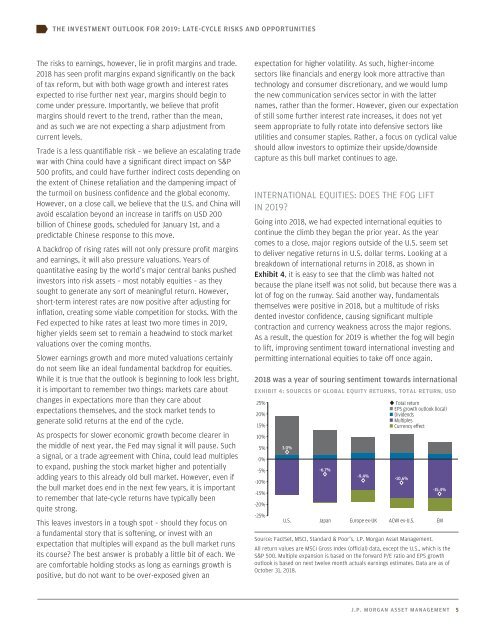Create successful ePaper yourself
Turn your PDF publications into a flip-book with our unique Google optimized e-Paper software.
THE INVESTMENT OUTLOOK FOR 2019: LATE-CYCLE RISKS AND OPPORTUNITIES<br />
The risks to earnings, however, lie in profit margins and trade.<br />
2018 has seen profit margins expand significantly on the back<br />
of tax reform, but with both wage growth and interest rates<br />
expected to rise further next year, margins should begin to<br />
come under pressure. Importantly, we believe that profit<br />
margins should revert to the trend, rather than the mean,<br />
and as such we are not expecting a sharp adjustment from<br />
current levels.<br />
Trade is a less quantifiable risk – we believe an escalating trade<br />
war with China could have a significant direct impact on S&P<br />
500 profits, and could have further indirect costs depending on<br />
the extent of Chinese retaliation and the dampening impact of<br />
the turmoil on business confidence and the global economy.<br />
However, on a close call, we believe that the U.S. and China will<br />
avoid escalation beyond an increase in tariffs on USD 200<br />
billion of Chinese goods, scheduled for January 1st, and a<br />
predictable Chinese response to this move.<br />
A backdrop of rising rates will not only pressure profit margins<br />
and earnings, it will also pressure valuations. Years of<br />
quantitative easing by the world’s major central banks pushed<br />
investors into risk assets – most notably equities – as they<br />
sought to generate any sort of meaningful return. However,<br />
short-term interest rates are now positive after adjusting for<br />
inflation, creating some viable competition for stocks. With the<br />
Fed expected to hike rates at least two more times in 2019,<br />
higher yields seem set to remain a headwind to stock market<br />
valuations over the coming months.<br />
Slower earnings growth and more muted valuations certainly<br />
do not seem like an ideal fundamental backdrop for equities.<br />
While it is true that the outlook is beginning to look less bright,<br />
it is important to remember two things: markets care about<br />
changes in expectations more than they care about<br />
expectations themselves, and the stock market tends to<br />
generate solid returns at the end of the cycle.<br />
As prospects for slower economic growth become clearer in<br />
the middle of next year, the Fed may signal it will pause. Such<br />
a signal, or a trade agreement with China, could lead multiples<br />
to expand, pushing the stock market higher and potentially<br />
adding years to this already old bull market. However, even if<br />
the bull market does end in the next few years, it is important<br />
to remember that late-cycle returns have typically been<br />
quite strong.<br />
This leaves investors in a tough spot – should they focus on<br />
a fundamental story that is softening, or invest with an<br />
expectation that multiples will expand as the bull market runs<br />
its course? The best answer is probably a little bit of each. We<br />
are comfortable holding stocks as long as earnings growth is<br />
positive, but do not want to be over-exposed given an<br />
expectation for higher volatility. As such, higher-income<br />
sectors like financials and energy look more attractive than<br />
technology and consumer discretionary, and we would lump<br />
the new communication services sector in with the latter<br />
names, rather than the former. However, given our expectation<br />
of still some further interest rate increases, it does not yet<br />
seem appropriate to fully rotate into defensive sectors like<br />
utilities and consumer staples. Rather, a focus on cyclical value<br />
should allow investors to optimize their upside/downside<br />
capture as this bull market continues to age.<br />
INTERNATIONAL EQUITIES: DOES THE FOG LIFT<br />
IN 2019?<br />
Going into 2018, we had expected international equities to<br />
continue the climb they began the prior year. As the year<br />
comes to a close, major regions outside of the U.S. seem set<br />
to deliver negative returns in U.S. dollar terms. Looking at a<br />
breakdown of international returns in 2018, as shown in<br />
Exhibit 4, it is easy to see that the climb was halted not<br />
because the plane itself was not solid, but because there was a<br />
lot of fog on the runway. Said another way, fundamentals<br />
themselves were positive in 2018, but a multitude of risks<br />
dented investor confidence, causing significant multiple<br />
contraction and currency weakness across the major regions.<br />
As a result, the question for 2019 is whether the fog will begin<br />
to lift, improving sentiment toward international investing and<br />
permitting international equities to take off once again.<br />
2018 was a year of souring sentiment towards international<br />
EXHIBIT 4: SOURCES OF GLOBAL EQUITY RETURNS, TOTAL RETURN, USD<br />
25%<br />
Total return<br />
• EPS growth outlook (local)<br />
20%<br />
• Dividends<br />
• Multiples<br />
15%<br />
• Currency effect<br />
10%<br />
5% 3.0%<br />
<br />
0%<br />
-5%<br />
-6.7%<br />
<br />
-9.4%<br />
-10%<br />
-10.6%<br />
<br />
-15.4%<br />
-15%<br />
<br />
-20%<br />
-25%<br />
U.S. Japan Europe ex-UK ACWI ex-U.S. EM<br />
Source: FactSet, MSCI, Standard & Poor’s, J.P. Morgan Asset Management.<br />
All return values are MSCI Gross Index (official) data, except the U.S., which is the<br />
S&P 500. Multiple expansion is based on the forward P/E ratio and EPS growth<br />
outlook is based on next twelve month actuals earnings estimates. Data are as of<br />
October 31, 2018.<br />
J.P. MORGAN ASSET MANAGEMENT 5
















